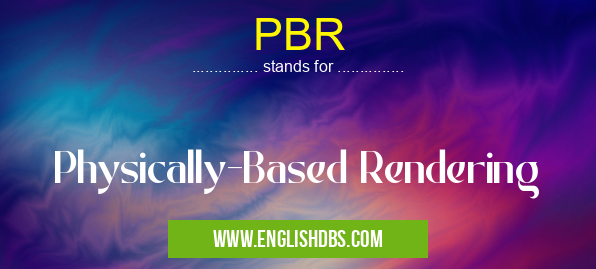What does PBR mean in COMPUTING
PBR (Physically-Based Rendering) is a rendering technique that accurately simulates the interaction of light with materials in a real-world environment. It utilizes physical principles and data-driven techniques to create realistic and immersive visual experiences in computer graphics.

PBR meaning in Computing in Computing
PBR mostly used in an acronym Computing in Category Computing that means Physically-Based Rendering
Shorthand: PBR,
Full Form: Physically-Based Rendering
For more information of "Physically-Based Rendering", see the section below.
PBR Meaning in COMPUTING
In the context of computer graphics, PBR refers to the process of rendering images using physically-based algorithms. These algorithms take into account the physical properties of materials, such as surface roughness, reflectance, and translucency, to produce realistic-looking images. PBR is fundamentally different from traditional rendering techniques, which rely on approximations and artistic interpretations.
Key Features of PBR
- Physically Accurate Materials: PBR utilizes materials that are defined by physically-based parameters, such as the refractive index, absorption coefficient, and surface roughness. This ensures that the rendered materials behave realistically under different lighting conditions.
- Energy Conservation: PBR follows the principles of energy conservation, ensuring that the amount of light entering a scene is equal to the amount of light leaving the scene. This results in physically plausible lighting interactions and removes artifacts such as energy loss or gain.
- Data-Driven Approach: PBR leverages real-world data, such as measured reflectance profiles and material scans, to create accurate and highly detailed materials. This data-driven approach reduces the need for manual tweaking and artistic interpretation.
Advantages of PBR
- Photorealism: PBR produces highly realistic and immersive visuals that are indistinguishable from real-world scenes.
- Flexibility: PBR materials can be easily modified and reused across different scenes and lighting conditions, allowing for rapid iteration and consistency.
- Compatibility: PBR is compatible with various software platforms and game engines, enabling artists to collaborate seamlessly.
Essential Questions and Answers on Physically-Based Rendering in "COMPUTING»COMPUTING"
What is Physically-Based Rendering (PBR)?
PBR is a rendering technique that simulates the way light interacts with real-world materials, resulting in more realistic and immersive visuals. It takes into account physical properties such as material roughness, metallic, and subsurface scattering to achieve accurate lighting, shading, and texturing in computer graphics.
What are the benefits of using PBR?
PBR offers several advantages over traditional rendering methods:
- Improved realism: PBR produces highly realistic images and animations by simulating the physical behavior of light.
- Material consistency: Materials created with PBR can be used across different lighting conditions and rendering engines, maintaining their visual accuracy.
- Reduced manual tweaking: PBR simplifies the process of creating realistic materials by automating many of the manual adjustments required in traditional methods.
What are some limitations of PBR?
While PBR is a powerful technique, it also has some limitations:
- Computational cost: PBR can be computationally expensive, especially when using high-quality materials and complex lighting setups.
- Material accuracy: The accuracy of PBR materials depends on the quality of the physical data used to create them.
- Artistic freedom: PBR aims to simulate reality, which can limit artistic expression and creativity in some cases.
Is PBR the only realistic rendering technique?
No, there are other rendering techniques that can produce realistic results, such as path tracing and ray tracing. However, PBR is widely used in the industry due to its balance between realism and computational efficiency.
Final Words: PBR is a revolutionary rendering technique that has transformed the field of computer graphics. By utilizing physically-based algorithms and data-driven materials, PBR delivers photorealistic and immersive visual experiences. Its advantages in flexibility, accuracy, and compatibility make it an indispensable tool for creating high-quality digital content. As technology continues to advance, PBR will continue to play a vital role in shaping the future of computer graphics and virtual reality.
PBR also stands for: |
|
| All stands for PBR |
